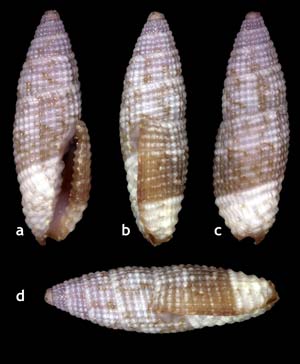Mollusca
Compiled by Gary Rosenberg
last updated 31 March 2004
Introduction
The phylum Mollusca includes organisms such as clams, snails, slugs, octopuses, squid, and chitons. As the phylum is currently defined, several features are common to all or most mollusks:
- A mantle that secretes calcium carbonate in the form of spicules or shell
- A mantle cavity where respiration occurs, usually through the ctenidium (gill) in aquatic forms, and where excretory and reproductive organs discharge
- A body divided into three regions, the head, foot, and visceral mass
- Three coelomic spaces, for kidney, heart and gonad,
- A radula, a ribbon of teeth used in feeding (absent in bivalves).
The living mollusks are divided into seven classes, Aplacophora, Monoplacophora, Polyplacophora, Gastropoda, Bivalvia, Scaphopoda, and Cephalopoda. All seven classes have marine representatives. Gastropods and bivalves are the most diverse groups, with about 35,000 and 10,000 known marine species respectively. Cephalopods are the most important commercially, being commerically fished in many regions.
Collecting
Historically most subtidal mollusks have been sampled by dredged and trawling, which means that the most intensive sampling has been on soft bottoms. A typical dredge haul might contain 90% dead shells and only 10% living specimens. Sampling on hard bottoms is more readily done by scuba diving, submersibles, or suction equipment, so knowledge of molluscan diversity in hard-bottom communities is still increasing rapidly. Dead shells can often be identified to the species level and so are worth collecting to document distribution patterns, but much more information can be gained from live-collected specimens. Most shallow water mollusks are nocturnal, so the chances of encountering living specimens and documenting their microhabitats and behavior are much great if sampling is done at night. The smallest adult mollusks are 0.3 to 0.4 mm, so appropriate mesh size must be chosen to ensure that some species are not overlooked.
Preservation
[In preparation]
Photography
There are a number of different body plans among mollusks, so there is no one orientation that is best for photography. With gastropods, an apertural view (fig. a) is usually most informative; standard position is with spire up and axis of coiling vertical. Lateral (fig. b), and abapertural (fig. c) views can also be useful. With the species illustrated in figures a-c, the apertural view corresponds to a ventral view, since in life position the axis of coiling would be horizontal (fig. d), but this is not true for all snails. In the species in figures e-f, the shell axis is at an angle when the shell is in life position (fig. f).
Pictures of live animals can often be posed in aquaria. Dorsal, lateral and head-on views are most useful. Ventral views can be taken with the animal crawling on glass. With shelled gastropods, after pictures of the active animal have been taken, it is useful to disturb it so that it retracts. This allows features of the shell, particularly the aperture, to be photographed. In the case of bivalves, interior features such as hinge teeth and configuration of muscle scars are important for identification, but cannot usually be documented while the animal is alive.
With shelled gastropods, after pictures of the active animal have been taken, it is useful to disturb it so that it retracts. This allows features of the shell, particularly the aperture, to be photographed. In the case of bivalves, interior features such as hinge teeth and configuration of muscle scars are important for identification, but cannot usually be documented while the animal is alive.
Resources
[Websites related to mollusks]
|
|
||||